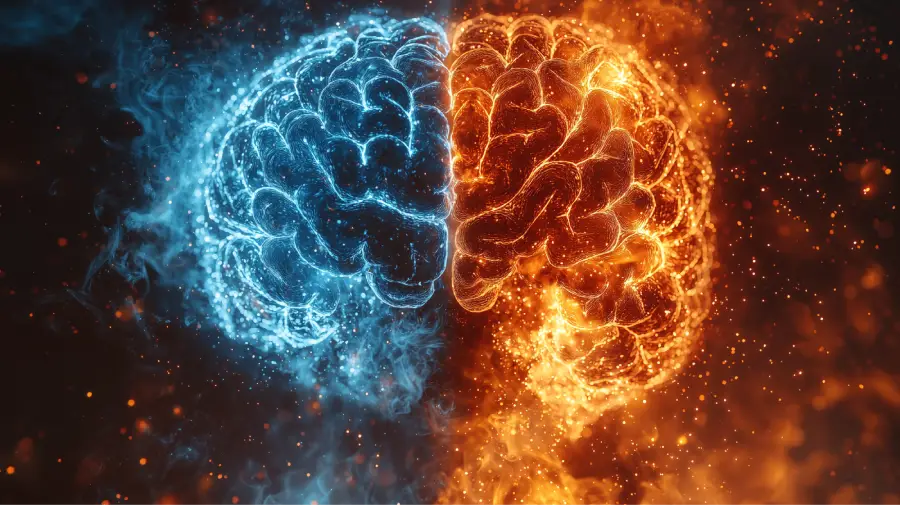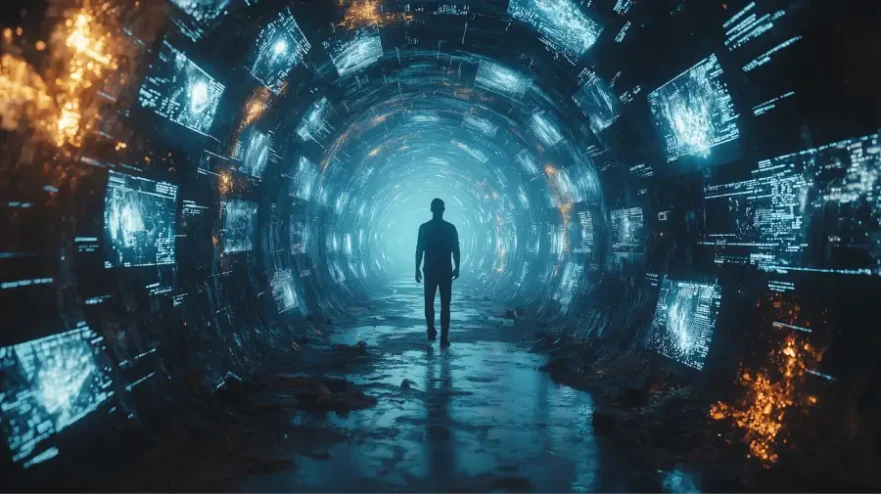Pornography promises instant pleasure—but what if it’s quietly costing you much more?
What begins as a harmless distraction or a way to unwind can quickly spiral into a habit that’s difficult to break, leaving you feeling trapped, anxious, and disconnected. With endless content always just a click away, resisting the pull can seem almost impossible.
In fact, according to SEMrush Traffic Analytics, U.S. porn sites receive more web traffic than Twitter, Instagram, Netflix, Pinterest and LinkedIn combined.
But beneath this popularity lies a hidden toll on mental health, relationships, and personal well-being.
This article uncovers the real impact pornography has on your brain, emotions, and behaviors, highlighting movements like NoFap that empower people to reclaim control and rediscover authentic satisfaction.
Pornography promises pleasure but may secretly erode well-being.
Understanding Porn Addiction
Porn addiction, or compulsive pornography use, is more than just an occasional habit—it’s a persistent behavior that can deeply disrupt your mental health, relationships, and everyday life.
While not officially classified as a mental health disorder in the Diagnostic and Statistical Manual of Mental Disorders (DSM-5), many healthcare professionals view it as a behavioral addiction, similar to substance abuse disorders.
The International Classification of Diseases (ICD-11) describes compulsive sexual behavior disorder (CSBD) as persistent, repetitive sexual impulses or behaviors that interfere with daily functioning.
Porn addiction means persistent use, even when it harms mental health, relationships and daily life.
Porn addiction doesn’t happen in isolation. It often emerges from underlying emotional issues like loneliness, depression, anxiety, low self-esteem, or unresolved trauma.
Combine these vulnerabilities with the ease and secrecy of online porn, and you have the perfect environment for compulsive behaviors to thrive.
The constant availability and normalization of porn make it uniquely challenging to resist—leading many into a cycle they never intended to enter.
Pornography’s Impact on Mental Health

Beyond its addictive potential, pornography has a profound impact on your mental health, altering brain chemistry and daily functioning.
How Porn Rewires the Brain
Research shows that frequent porn use hijacks the brain’s reward system and changes the brain’s structure, much like addictive substances.
This means that prolonged pornography use can weaken natural pleasure responses and reinforce compulsive behavior.
A 2014 study found that heavy porn users showed significantly reduced activity in critical areas of the brain responsible for motivation and impulse control, suggesting long-term neurological rewiring.
Dopamine and the Cycle of Addiction
At the heart of porn’s addictive nature is dopamine, a powerful chemical released by your brain during pleasurable activities. While dopamine is healthy in moderation, pornography triggers unnaturally high and sustained dopamine spikes, surpassing even natural sexual experiences.
To put this into perspective:
- Eating increases dopamine levels to 150% of normal production.
- Nicotine raises it to 200%.
- Sexual activity spikes it to 250%.
- Pornography exceeds even that—elevating dopamine beyond 250% and sustaining it for hours.
Even cocaine, one of the most addictive substances, produces a sharper spike—but it fades faster than pornography’s prolonged effect.
This prolonged dopamine release leads to desensitization, meaning your brain needs increasingly extreme or novel content to achieve the same satisfaction—a hallmark of addiction.
As a result, you may find yourself constantly seeking more intense material, mirroring the tolerance patterns observed in substance abuse disorders.
Escalation and Dependence

Pornography is unique in its addictive potential—it’s instant, endless and always available.
Unlike substances that run out or require effort to obtain, porn provides immediate gratification at any moment, making it alarmingly easy to develop compulsive habits.
This makes compulsive consumption easier to develop and harder to resist.
With unlimited access, you may find yourself watching more than you intended—even when you’re fully aware of the negative impact it’s having on your life.
Over time, activities and relationships you once genuinely enjoyed may start to lose their appeal, replaced by an escalating dependence on pornography
As the brain adapts, what once satisfied no longer does.
You may also experience diminished arousal with a real partner, pushing you toward more extreme or intense content just to feel the same level of excitement.
This doesn’t just affect you—it strains relationships too.
Heavy porn use is tied to loneliness and emotional distance in relationships. The secrecy surrounding this habit can also erode trust, creating feelings of betrayal, resentment, and isolation.
As the cycle escalates, it’s easy to feel powerless against these urges.
Some may even engage in risky behaviors that further harm their mental and emotional health.
Recognizing this escalation is essential to reclaiming control, restoring your relationships, and protecting your emotional well-being.
When Porn Addiction Becomes Destructive
Quitting pornography isn’t always as simple as deciding to stop.
You may experience withdrawal symptoms like irritability, restlessness and intense cravings—clear signs of dependence.
At this stage, addiction is no longer about seeking pleasure—it’s about avoiding discomfort.
Over time, the brain rewires itself to treat pornography as a necessary source of relief.
Your brain learns to see pornography not just as entertainment, but as an essential source of relief.
Early in addiction, cycles of heightened reward (sensitization) and reduced satisfaction (desensitization) trick your mind into believing porn is vital—even necessary—for emotional well-being.
Losing Control: The Brain on Autopilot
Over time, addiction can weaken the brain’s ability to regulate impulses—a condition known as hypofrontality.
This means critical regions (like the frontal cortex and anterior cingulate) responsible for decision-making, impulse control, and resisting harmful behaviors become impaired. Normally, these brain areas help you resist instant gratification in favor of long-term rewards—but with addiction, pornography is perceived as incredibly valuable, worth pursuing at almost any cost.
Many who struggle with porn addiction describe feeling trapped, operating on autopilot, desperate to stop but seemingly unable to do so.
Long-Term Consequences: Brain Shrinkage and Neurological Damage
Heavy pornography use isn’t just psychologically damaging—it can physically alter your brain.
Recent research shows a clear link between excessive porn consumption and structural brain changes.
Recent studies link porn addiction to brain shrinkage and weaker connections in areas that control decision-making and impulses.
MRI studies reveal that men who consume large amounts of pornography tend to have less grey matter—the brain tissue essential for complex thinking—than those who watch less.
Another study found that heavy porn use disrupts neural pathways, making it harder to regulate impulses and maintain self-control.
Some studies have even associated high levels of pornography consumption with increased aggression and a greater likelihood of harmful sexual behaviors.
These neurological changes highlight the long-term impact of excessive porn use on the brain.
As a result, many who choose recovery seek healthier alternatives, reconnecting with authentic sources of satisfaction and reclaiming control over their lives.
Women and Porn Addiction
Porn addiction is often portrayed as a problem exclusive to men—but women struggle with it too, frequently in isolation and silence. Porn addiction isn’t just a men’s issue. Women struggle too, often in silence.
A 2019 study found that 11% of men and 3% of women feel addicted to pornography, a number likely underreported due to stigma and shame.
Research shows compulsive pornography use among women is rising, yet many hesitate to seek help, fearing judgment.
For many, addiction isn’t just about habit—it’s tied to shame, past trauma and the urge to escape painful emotions.
Unfortunately, the fear of judgment and societal misconceptions prevent many women from seeking help, keeping them locked in a cycle of shame and self-blame.
Women who experience compulsive sexual behavior often use it as a way to numb distress, only to be trapped in a cycle of avoidance and self-blame.
To address this, healing must start with self-compassion, not shame.
While recovery is deeply personal, the way we talk about porn and addiction matters.
Overcoming porn addiction takes more than willpower.
A mental health professional can help you address the deeper emotional and psychological factors driving this addiction, guiding you toward healthier coping strategies and long-term change.
Beyond individual recovery, public education and awareness are key to reshaping how society understands pornography and its effects.
While recognizing the roots of porn addiction is crucial, its impact reaches far beyond compulsive use.
Looking For Therapy?
Start Healing Today.
212-960-8626
Breaking Free: Therapy for Porn Addiction
Deciding to seek help for porn addiction is a powerful step toward reclaiming your life.
True recovery is about understanding why you turn to porn and developing healthier ways to cope. Several therapy approaches can help:
- Behavioral Addiction Therapy: Specifically designed for compulsive behaviors, this therapy addresses the underlying psychological patterns reinforcing addiction. It helps you identify addictive triggers, disrupt harmful routines, and cultivate new habits to support long-term recovery.
- Cognitive Behavioral Therapy (CBT): Porn addiction feeds on habit and negative self-talk. CBT helps you identify triggers, challenge harmful patterns and replace compulsive behaviors with healthier coping strategies.
- Dialectical Behavior Therapy (DBT): If intense emotions, shame or self-criticism fuel your addiction, DBT can help. This approach teaches emotional regulation and impulse control, helping you manage distress without turning to porn.
- Eye Movement Desensitization and Reprocessing (EMDR): This is a powerful therapy for those using porn to escape past trauma. EMDR helps reprocess distressing memories, reducing their emotional charge and breaking the cycle of addiction.
- Mindfulness-Based Therapy: Porn addiction often runs on autopilot as an escape from discomfort. Mindfulness therapy teaches you to pause, observe urges without reacting and reclaim control over your choices.
Overcoming porn addiction means moving from shame and secrecy toward self-awareness and compassion—equipping you with lasting tools to build a healthier life.
Masturbation Without Porn: A Healthier Alternative?

Quitting pornography is not easy.
One of the biggest challenges people face is finding healthy ways to manage sexual urges without returning to compulsive behaviors.
For some, masturbation without pornography can become a positive strategy, offering an opportunity to reconnect with sexuality, rediscover genuine pleasure, and recalibrate the brain’s overstimulated reward system.
Without the artificial stimulation of porn, the brain can recalibrate to a healthier sexual baseline.
However, this approach isn’t right for everyone. Some individuals discover that complete abstinence—even temporarily—provides greater clarity, self-control, and emotional well-being.
The NoFap Movement: A Path to Recovery

As awareness of pornography’s impact grows, support groups and movements like NoFap have emerged to help individuals break free from compulsive use.
Founded as a community-driven initiative, NoFap encourages abstinence from both pornography and masturbation, aiming to promote self-discipline, mental clarity, and emotional health.
Participants frequently report meaningful personal benefits, such as increased motivation, improved social confidence, reduced anxiety, and a stronger sense of purpose. While scientific research around NoFap is still evolving, anecdotal evidence from thousands of participants consistently highlights these positive outcomes.
According to Healthline, many who adopt a NoFap lifestyle report reduced anxiety, improved social skills, increased motivation and a stronger sense of purpose—findings that align with testimonials from NoFap participants.
One of the movement’s core principles is rebuilding intimacy—both with yourself and with others.
By stepping away from pornography, individuals can foster deeper emotional connections, replacing unrealistic expectations with genuine, fulfilling relationships.
Many also find that abstaining boosts self-confidence and body image, reducing self-doubt and improving overall well-being.
If you’re seeking a structured, supportive path to reset your relationship with sexuality, NoFap offers practical guidance and community support.
At its core, NoFap is about taking back control of your mind and body.
How Shame and Stigma Hinder Recovery
One of the biggest obstacles to overcoming porn addiction isn’t just the habit itself—it’s the shame that surrounds it.
Society sends mixed messages, normalizing porn as a common pastime while simultaneously stigmatizing those who struggle with compulsive use.
This leaves many feeling isolated, embarrassed, and reluctant to seek the help they desperately need.
The fear of judgment can be paralyzing, making it difficult for individuals to acknowledge the problem, let alone reach out for support.
However, healing starts with breaking the silence.
Understanding that compulsive porn use is a behavioral issue—not a reflection of your character or worth—can help lift the weight of shame, encouraging a compassionate, open approach to recovery and meaningful change.
What it Means to Truly Recover
When you break free from compulsive porn use, you create space for personal growth, emotional healing, and genuine fulfillment.
The benefits extend far beyond simply stopping a behavior:
- Stronger Relationships: Reconnect with your loved ones, build trust and experience deeper intimacy in your relationships.
- Heightened Focus & Productivity: Wake up with more energy, tackle your goals with clarity and regain the motivation to pursue your passions.
- Enhanced Confidence & Professional Growth: Sharpen your focus at work, boost your creativity, and approach challenges with a renewed sense of discipline and drive.
- Empowered Self-Control: Feel the strength of making conscious choices, breaking free from compulsions and reclaiming full autonomy over your life.
Choosing recovery is choosing yourself—and while the journey may have its ups and downs, every step forward brings rewards worth striving for.
Conclusion

Pornography doesn’t just offer a temporary escape—it changes your brain, disrupts intimacy, and can normalize unhealthy sexual behaviors.
While its classification as a diagnosable condition remains debated, growing evidence suggests it shares key traits with other behavioral addictions—including compulsive use reinforced by dopamine-driven cravings.
Breaking free from this cycle can be challenging, but it’s entirely achievable.
Many who step away from compulsive use report greater confidence, stronger relationships and improved mental well-being.
Movements like NoFap provide a sense of community and support, helping individuals navigate this journey toward self-discipline and emotional clarity.
While more research is needed on NoFap’s long-term effects, one thing is clear: choosing to quit pornography can be a powerful step toward personal growth.
Choosing recovery is a courageous, life-changing decision. It’s not always easy—but you’re not alone on this journey.
If you’re tired of feeling stuck, our porn addiction therapists are here to support you every step of the way, helping you regain control, rebuild your confidence, and rediscover your true potential.
Our therapists can help you break free and rebuild confidence.
Take that first step today—your future self will thank you.

